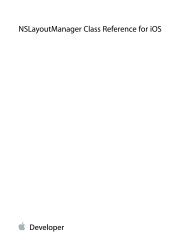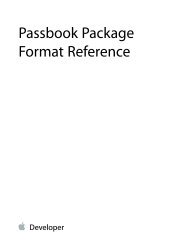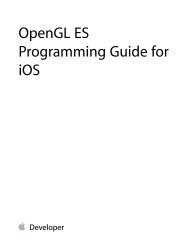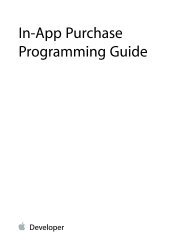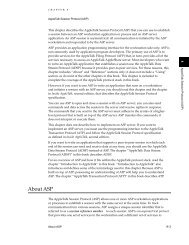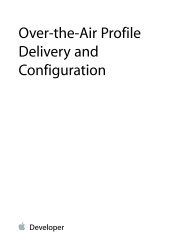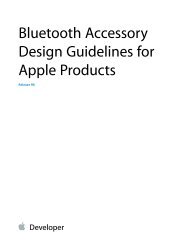URL Loading System Programming Guide - Apple Developer
URL Loading System Programming Guide - Apple Developer
URL Loading System Programming Guide - Apple Developer
You also want an ePaper? Increase the reach of your titles
YUMPU automatically turns print PDFs into web optimized ePapers that Google loves.
Life Cycle of a <strong>URL</strong> Session<br />
You can use the NS<strong>URL</strong>Session API in two ways: with a system-provided delegate or with your own delegate.<br />
In general, you must use your own delegate if your app does any of the following:<br />
●<br />
●<br />
●<br />
●<br />
●<br />
●<br />
●<br />
Uses background sessions to download or upload content while your app is not running.<br />
Performs custom authentication.<br />
Performs custom SSL certificate verification.<br />
Decides whether a transfer should be downloaded to disk or displayed based on the MIME type returned<br />
by the server or other similar criteria.<br />
Uploads data from a body stream (as opposed to an NSData object).<br />
Limits caching programmatically.<br />
Limits HTTP redirects programmatically.<br />
If your app does not need to do any of these things, your app can use the system-provided delegates. Depending<br />
on which technique you choose, you should read one of the following sections:<br />
●<br />
●<br />
“Life Cycle of a <strong>URL</strong> Session with <strong>System</strong>-Provided Delegates” (page 64) provides a lightweight view of<br />
how your code creates and uses a <strong>URL</strong> session. You should read this section even if you intend to write<br />
your own delegate, because it gives you a complete picture of what your code must do to configure the<br />
object and use it.<br />
“Life Cycle of a <strong>URL</strong> Session with Custom Delegates” (page 66) provides a complete view of every step in<br />
the operation of a <strong>URL</strong> session. You should refer to this section to help you understand how the session<br />
interacts with its delegate. In particular, this explains when each of the delegate methods is called.<br />
Life Cycle of a <strong>URL</strong> Session with <strong>System</strong>-Provided Delegates<br />
If you are using the NS<strong>URL</strong>Session class without providing a delegate object, the system-provided delegate<br />
handles many of the details for you. Here is the basic sequence of method calls that your app must make and<br />
completion handler calls that your app receives when using NS<strong>URL</strong>Session with the system-provided delegate:<br />
1. Create a session configuration. For background sessions, this configuration must contain a unique identifier.<br />
Store that identifier, and use it to reassociate with the session if your app crashes or is terminated or<br />
suspended.<br />
2013-10-22 | Copyright © 2003, 2013 <strong>Apple</strong> Inc. All Rights Reserved.<br />
64




